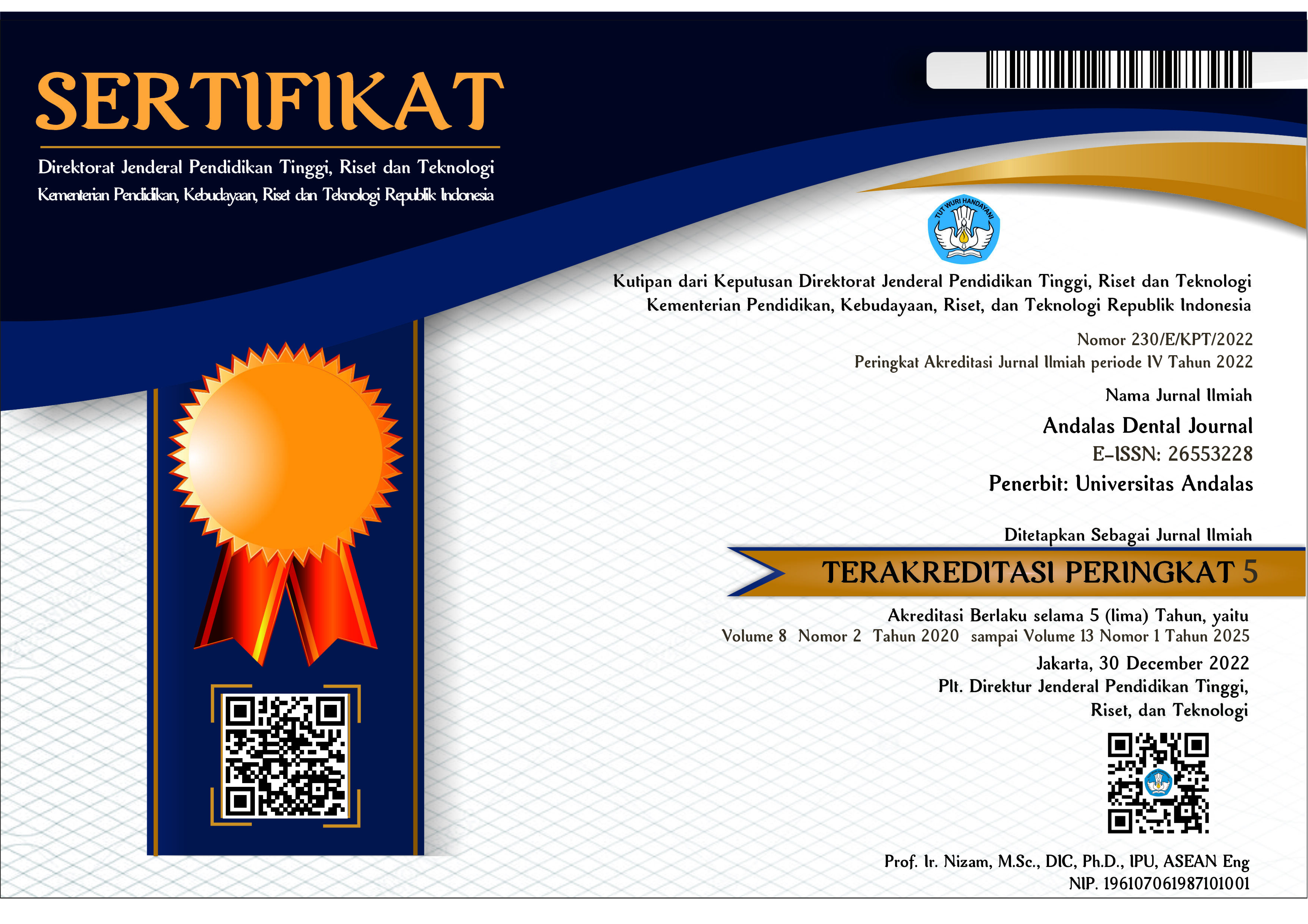PERBANDINGAN KEBOCORAN MIKRO PADA RESTORASI RESIN KOMPOSIT MIKROFILLER DENGAN RESIN-MODIFIED GLASS IONOMER CEMENT (RMGIC) PADA KAVITAS KLAS V GIGI ANTERIOR
Abstract
Microleakage defined as the clinically undetectable passage of bacteria, fluids, molecules or ions between a cavity wall and the restorative material. Microleakage tends to occur in Class V cavities. It is caused by marginal adaptation which is more difficult in class V cavities. Microfiller composite resin is developed and indicated for areas that not require a large pressure. As the development of dental materials, it has been developed a composite resin base material that is known as resin-modified glass ionomer cement. This material has purposed to reduce the limitation of conventional glass ionomer cement and take the advantage of the composite resin material.
The aim of this study was to evaluate microleakage difference of microfiler composite resin restoration with resin-modified glass ionomer cement restorations in class V anterior teeth cavities. The methode of this study used experimental laboratory through in vitro process . Thirty two class V cavities were prepared on labial surfaces of extracted human anterior teeth. Samples were divided into two groups. Group I included sixteen samples that have had restorated with microfiller composite. Group II included sixteen samples that have had restorated with resin-modified glass ionomer cement. The samples were immersed into aquabides solution for 24 hours. After that, the samples were immersed into 1% methylene blue solution for 24 hours. All samples sectioned longitudinally and analyzed for microleakage as dye penetration using a stereomicroscope.
Student t-test were used for statistical analysis. The resulting data showed no significantly difference between two groups.
Key Word : Microleakage, microfiller composite resin, resin-modified glass ionomer cement (RMGIC), class V cavities.
References
2. Powers JM, Sakaguchi RL. Craig’s Restorative Dental Materials. Elsevier
3. Anusavice. Buku Ajar Ilmu Bahan Kedokteran Gigi. 10th rev. Transl. Budiman JA, Purwoko S, Translator. Jakarta: EGC, 2003.
4. Lokhande N, Padamai A, Rathore V. Effectiveness Of Flowable Resin Composite in Reducing Mickroleakage. J Inter Oral Health. 2014 Jun;6(3):111-114.
5. Cimello DT, Chinelati MA, Ramos RP, Palma RG. In Vitro Evaluation of Microleakage of a Flowable Composite in Class V Restorations. Braz Dent J. 2002;13(3).
6. Nicholson JW. The Chemistry of Medical and Dental Materials. 1st rev. ed. Connor JA, Editor. UK: The Loyal Society of Chemistry, 2002.
7. Bonsor SJ, Pearson GJ. A Clinical Guide to Applied Dental Materials. 1st rev. ed. British: Elsevier, 2013.
8. Van N. Introduction To Dental Materials. USA: Elsevier; 2007.
9. Sing M, Palekar A. Polymerization Shrinkage of Composite Resin. NJDSR. 2014 Jan 1;2(1):58-61.
10. Mousavinasab SM, Khosravi K, Tayebghasaemi N. Microleakage Assesment of Class V Composite Restorations Rebonded with Three Different Methods. Dent Res J. 2008;5(1):21-26.
11. Graham JM, Hume WR. Preservation and restoration of tooth structure. Mosby; 1998.
12. McCabe JF, Walls AWG. Apllied Dental Materials. 9th rev. ed. Oxford: Blackwell, 2008.
13. Majeed, Abdul. An Invitro Study of Microleakage and Surface Microhardeness of Nanocomposite Restorative Materials. A minithesis submitted in partial fullfilment of requirements for degree of Master of Science in Restorative Dentistry. Faculty of Dentistry of thr Western Cape; 2005.
14. Soratur SH. Essensial of Dental Materials.1st rev. ed. New Delhi: Jaypee Brothers Medical,2002.
15. Giachetti L, Russo DS, Bambi C, et all. A Review of Polymerization Shrinkage Stress : Current Techniques for Posterior Direct Resin Restorative. The Journal of Contemporary Dental practice. 2006 Sep 1;7(4):1-14.
16. Karthick K, Kailasam S, Priya, et all.mPolymeryzation Shrinkage of Composite. JIADS. 2011 Apr-Jun;2(2):32-36.















